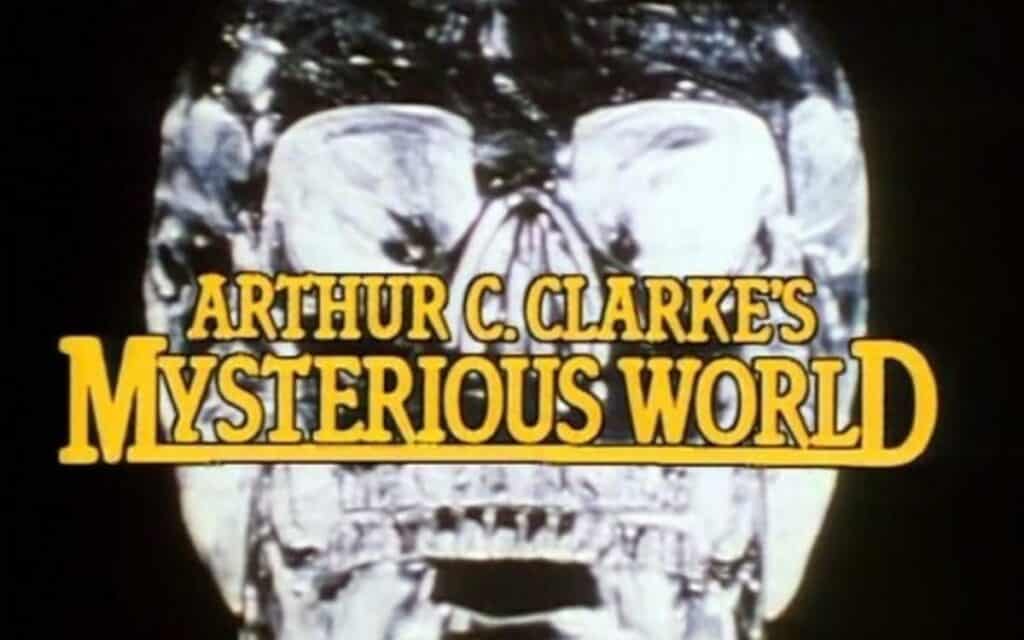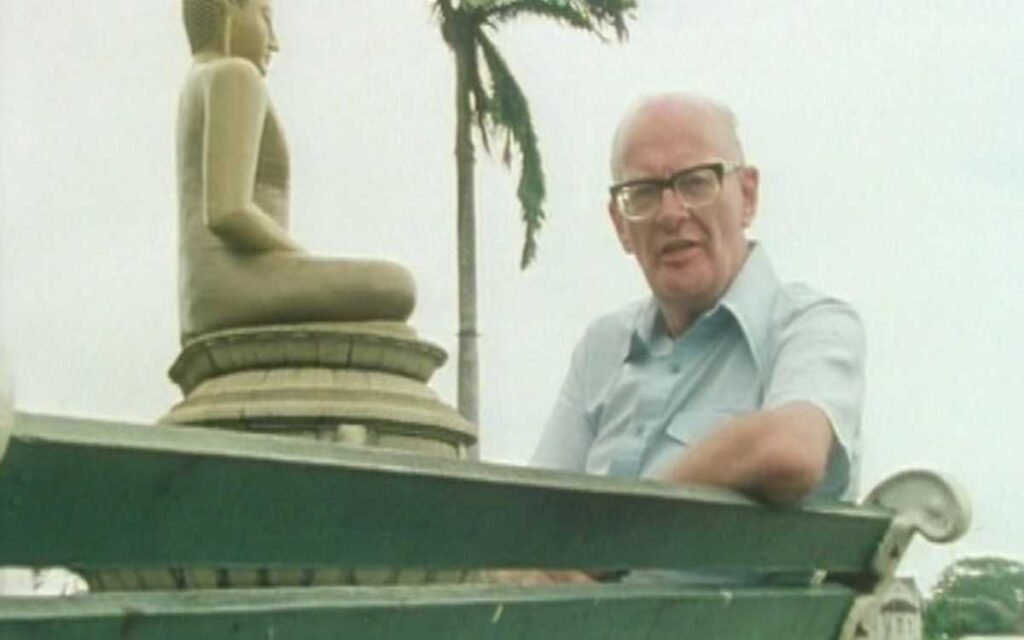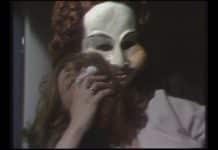CHRISTINE MILLER takes a look back at Arthur C. Clarke’s Mysterious World television series…
In 1980, esteemed science-fiction writer Arthur C. Clarke delved into the secrets of the unknown for the television series Arthur C. Clarke’s Mysterious World, produced by Yorkshire Television.

Who Was Arthur C. Clarke?
Arthur C. Clarke was born in Minehead, Somerset, on 16th December 1917 and was the eldest of four children. As a young child, he became fascinated with science – particularly space – and would spend many hours stargazing and pondering the unknowns that space held.
It was an obsession that would last a lifetime.
When pursuing a literary career as an adult, Clarke began writing for various science fiction magazines. By 1968 his most famous novel, 2001: A Space Odyssey, was released while simultaneously being made into a film by Stanley Kubrick. It is widely regarded as one of the most influential films ever to be made.
Clarke died on 19th March 2008, in Sri Lanka, where he had first emigrated back in 1956.
He was 90 years old.

Arthur C. Clarke’s Mysterious World
The series Arthur C. Clarke’s Mysterious World, first aired on ITV in 1980, still has the distinct ability to unsettle today. Not only for its stories of some truly incredibly anomalies here in the UK and further afield but also for its jarring theme tune and ensuing soundtrack throughout (not to mention the skull set into the opening titles that cements the creepy feel beautifully).
And, there is something strangely comforting about the grainy film footage of the early 80s in each of the 13, 25-minute episodes that span a range of fascinating subjects.
Each of the episodes would offer expert analysis and discussion, as well as original photos and eyewitness testimony from a variety of people of interest.
From UFOs to monsters of the deep, the series examined some of the hottest esoteric topics of the day.
The series delved into just about every famous type of mystery around at the time, some of which still lives on today. From The Loch Ness Monster, the so-called Robert Taylor incident, Stonehedge, other ancient stone circles such as Avebury and Newgrange, as well as tales of raining animals, Bigfoot, and so much more.
While Gordon Honeycombe narrated, Clarke would open and close each episode from Sri Lanka, where he was spending his retirement. At the end of each episode, Clarke would offer his objective findings on the likelihood of the episode’s subject being genuine phenomena or merely unfounded superstitious murmurings.
Spoiler: It was usually, but not always, the latter.
Although Clark’s role in the series isn’t the most significant gig he’s ever been a part of, his input is profoundly vital to lending a feel of authoritative wisdom to the series.
After all, this was the man that is supposedly said to have made some rather accurate space predictions that turned out to be true.
But, it didn’t end with Arthur C. Clarke’s Mysterious World; the explosively popular series was followed up five years later by Arthur C. Clarke’s World of Strange Powers and, in 1994, with Arthur C. Clarke’s Mysterious Universe.
Over 40 years on from when it first aired, Arthur C. Clarke’s Mysterious World is still a fascinating watch. And, although dated, the series continues to find a new, enthusiastic audience.
After all, there’s nothing like a bit of nostalgia, is there?
Arthur C. Clarke’s Mysterious World Episode Guide
Below you can find details on the 13 episodes that compile Arthur C. Clarke’s Mysterious World.
The Journey Begins
The introductory episode is divided into three sections, where mysteries were divided into either first, second or third kind phenomena.
First kind relates to subject matters which were once enigmas to man, such as a solar eclipse. The second pertains to the unsolved, but there is (or was, back in the early 80s) scientific theory to suggest an explanation, like ball lightning, for example. Lastly, the third kind refers to events with no rational explanation.
Monsters of the Deep
The episode focuses on underwater mysteries and includes terrifying encounters with the Serpent of the Sea in Cornwall. This giant squid was allegedly witnessed to have attacked and ultimately sank a ship, as well as sightings of a terrifying megamouth shark.
Ancient Wisdom
“Ancient Wisdom” explores the curious technologies that ancient civilisations held, which suggest they were much more advanced than science has currently given them credit for.
Or, were greater forces at play?
The Missing Apeman
An episode dedicated to unravelling the puzzle of the Yeti and Bigfoot sightings throughout both North America and the Himalayas, offering eyewitness testimony from those who claim to have observed the creatures for themselves.
Giants for the Gods
Giants of the Gods tries to unravel the purpose of geoglyphs and large displays covering masses of ground produced by our ancestors across a host of civilisations. The episode asks what exactly were they created for, and could they have been designed to be seen by those not of this planet?
Monsters of the Lakes
This episode travels to Scotland and Canada to look at the bizarre beings that have been seen and whispered about for centuries, namely The Loch Ness Monster and Ogopogo.
The Great Siberian Explosion
Analysing the Tunguska explosion, which occurred in 1908, this episode attempts to delve further into the mystery, proposing various explanations for the incident, from meteor to black hole to even an atomic bomb.
The Riddle of the Stones
The eighth instalment of the series focuses on the ancient stones found throughout the world, particularly within the UK, such as Stonehenge and questions, what was their purpose and can humankind ever definitely uncover their true purpose.
Out of the Blue
Clarke addresses the phenomena of unusual objects falling out of the sky and why this might happen. From curious matters of it running fish to frogs hurtling to earth from our skies en masse, this episode tries to find the truth as to what causes such unusual cases throughout the world.
U.F.Os
Detailing the phenomena of “flying saucers”, this episode puts forward a compelling case for the existence of UFOs, with Clarke himself claiming to have witnessed at least six UFOs in his 50+ years of research. The episode discusses occurrences such as the “Robert Taylor incident”, a particularly famous UFO sighting in Scotland in 1979.
Dragons, Dinosaurs and Giant Snakes
This episode includes mysterious tales of cryptozoology, including the De Loys’ ape, a strange primate named after the geologist who photographed the being in 1920. The episode also focuses on excavations of the long-extinct woolly mammoth, moa and giant anaconda.
Strange Skies
The penultimate episode in the series includes discussion on the lost planet known as Vulcan, the Martian canals, and explanations for what the Star of Bethlehem was.
Clarke’s Cabinet of Curiosities
Closing the series is a round-up of some of the most perplexing tales that have been analysed throughout previous episodes of Mysterious World.








What a great writer! Christine Miller always does a good job of explaining complex subjects in an easy-to-understand format.